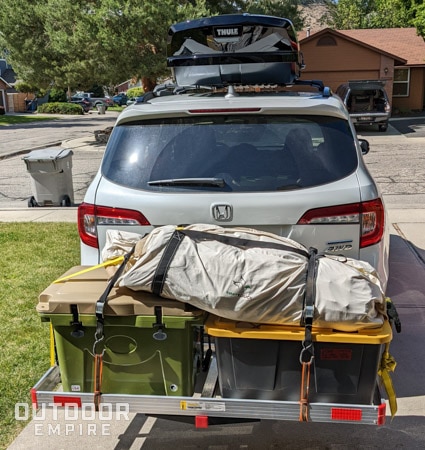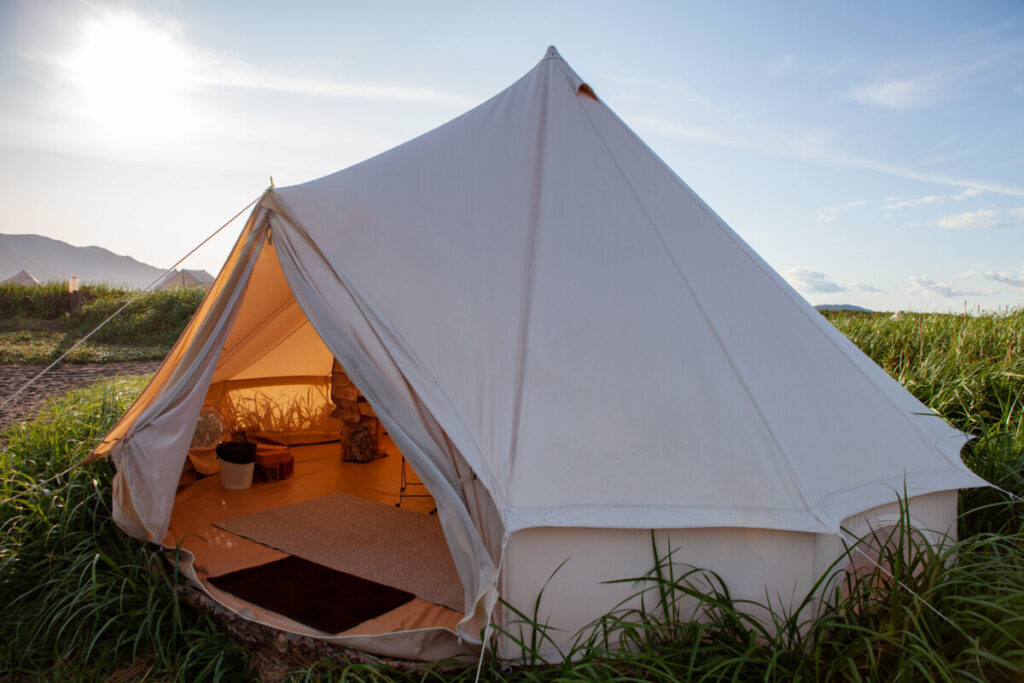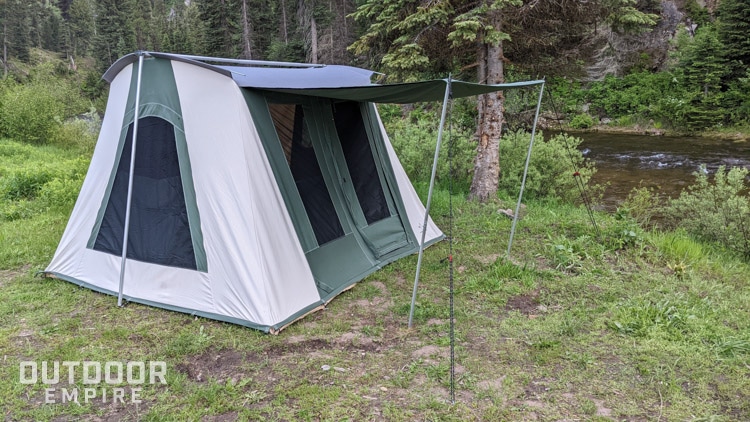When you go camping, you need to bring a good tent. But before that, you have to decide whether to get a nylon or canvas tent. Is a canvas tent better than a nylon tent?
I’ve camped extensively in both canvas and nylon tents. They both serve a purpose. If I’m car camping, have the space, taking my family or friends, and will be spending more than a night or two in the woods, I prefer a big canvas tent. But if I’m tight on space in the car, backpacking, or just doing a quick overnighter, I think a small nylon tent is more convenient. So I have both!
Canvas tents are better at keeping you warm in the winter and cool in the summer. They are also more durable and last longer. However, nylon tents are typically more lightweight, cheaper, and easier to set up and take down.
What is certain is that I prefer a canvas tent for bad weather as well as for really hot or really cold temperatures. I also love that you can repair them when they tear (which all tents will if you actually use them), whereas nylon tents have a shorter shelf life.
Here’s a summary of the pros and cons of canvas tents:
Pros
- Stay warmer in winter
- Stay cooler in summer
- Can have a wood stove inside (certain models)
- Super durable and long-lasting
- Keep the elements out
- Repairable when they tear
Cons
- Heavy and bulky, harder to transport and move around
- Susceptible to mold if stored wet
- Can be complex to set up (but not always)
- Not cheap (but on par with nicer nylon tents)
Let’s go over these pros and cons in more detail so you can better decide whether a canvas tent makes sense for you.
We bought and tested a pile of canvas tents. Read the full review!
Benefits of Canvas Tents
1. They will keep you warm!
Canvas tents stay warm during the winter due to their thick walls. The insulation will keep the warm air in and the cool air out. This is especially nice on cold nights because the warm air from the day will stay in your tent to keep you better heated at night.
Some canvas tents allow you to put in heaters or wood stoves, which helps keep the canvas tent even warmer. You would never consider putting a heater or wood stove in a nylon tent as it is a serious safety hazard.
2. They will keep you cool!
In the summer, canvas tents stay cool because the sun can’t penetrate the thick canvas material as easily. If you let in some cool air through a window or door, you can then close the doors and keep that nice cool air trapped in. Eventually, the tent will heat up in the sun, but you’ll be able to stay cooler longer in a canvas tent.
3. Canvas is extremely durable.
Much more so than nylon tents. This is because the canvas is extremely thick and the seams are sewn with a more durable thread.
When taken care of properly, canvas tents are known to last for well over ten years, which is double the expected lifespan of nylon tents.
4. They keep water out.
This is extremely helpful when it rains so you don’t end up with puddles in the corners or drips from the top of your tent like you would with nylon.
And even with snow, canvas performs fantastically well. Many canvas tents make great 4-season shelters thanks to their sturdy structure and ability to keep the elements out. Canvas is definitely my preferred choice for late-season hunting camp or winter camping whenever possible.
Canvas is also very breathable, meaning you won’t get that yucky sticky feeling while sleeping in a canvas tent. It will also dry quickly when it does rain, or just from the morning dew.
5. Canvas tents can be repaired.
If they rip or are damaged, canvas tents can be patched with needle, thread, and canvas (duh). This is not the case for nylon tents.
However, it can be expensive to repair a severely damaged canvas tent. You need to purchase the proper material and thick thread. After you finish repairing a canvas tent, you also have to treat it so it remains waterproof, and the seams are completely sealed.
Although canvas tents are great, they are not perfect, and there are cons to owning one.
Drawbacks of Canvas Tents
1. Canvas tents are big and heavy.
Depending on the design, the poles that hold up a canvas tent are often large and heavy. The canvas material isn’t lightweight either and it doesn’t pack down nice and small. Because of their weight and bulk, they are not suitable for hiking or backpacking. You’ve either got to be car camping or packing into the backcountry with horses, mules, or OHVs for canvas to make practical sense.
Medium-sized canvas tents typically weigh between 50 and 80 pounds, while larger ones can weigh more. If you’re driving up to your site that may be ok, even if it’s a bit hard to get out of the car.
I find it most convenient to transport my canvas tent on a hitch carrier on the back of our SUV. While I can move it around myself, it’s easier when my wife gives me a hand.

2. They cannot be packed when they are damp.
If they are packed when damp, they will become a breeding ground for mildew. If left for long enough, mold can start to develop. This typically doesn’t build up as much or as quickly on nylon tents, but it still can.
Whether you have a canvas or a nylon tent, be sure to let it dry completely before packing it up so it doesn’t develop mold or mildew. Mold can clean more easily from nylon tents and can be a big problem with canvas tents, but either way, it’s an issue.
If your tent is wet or it’s raining when you’re packing up to go home, be sure and take your tent out later to hang dry in your garage or outside on a nice day before long-term storage.
3. Canvas tents can be challenging to put together.
It can take up to an hour to finish setting up a canvas wall tent or a trendy glamping bell tent, even when multiple people work together. They are heavy and bulky and that can be frustrating when you’re trying to get your campsite put together.
However, this is not the case with all canvas tents, like the classic Springbar design. This is the design of my canvas tent and I can set it up by myself in about 10 or 15 minutes, as fast as any nylon tent. You’ve got to stake it down first, then there are just two side posts and the roof system that go together and stand up lickity split.
You can find this style from several manufacturers including Springbar, Kodiak Canvas, White Duck Outdoors, and Teton Sports. These are not freestanding tents like many nylon tents. They require stakes, but so do pretty much all canvas tents.
4. They can be expensive.
When you go camping you often have a lot of gear to buy. A canvas tent may simply not be in the budget when you have all those other things to consider. And you can certainly find cheap nylon tents that will save you some cash even compared to a cheap canvas tent.
That said, a nice, large, family nylon tent can easily fall within the same price range as a canvas tent these days.
Are Canvas Tents Worth the Money?

Canvas tents typically cost between $500 and $1,000. Though you can find some basic small ones for as cheap as $200, or spend a few thousand bucks to purchase a high-quality canvas wall tent that is extremely large.
Canvas tents are worth the money if you use them often, go on extended camping trips, and are willing to take the time to set them up and take care of them properly. If you want a tent that will stay warm in the winter and cool in the summer, and is large enough to fit your entire family with ease, a canvas tent could be the perfect match. This is the case for my family of five plus Huck the dog.
If you want to buy one tent that will last you and your family your whole life, I’d bet on a canvas tent.
However, beginning campers, soloists, couples, and hikers often prefer using nylon tents because they are cheaper, lighter, and easier to set up or take backpacking. Just keep in mind that you may be buying another nylon tent (or switching to canvas) down the road.
Conclusion
Overall, canvas and nylon tents each serve different needs, and there are many pros and cons to canvas tents. Ultimately you must consider your budget, how you’ll use it, and your willingness to properly care for a tent.
If you want something quick, cheap, and simple then a canvas tent probably isn’t for you. But if you’re looking to invest your money in a tent that can work for years and provide more comfort, you can’t go wrong with a canvas tent.
We answered 9 FAQs about canvas tents, a must-read before buying. We also suggest you check How To Select The Right Tent Size for Camping (+ Size Chart).






